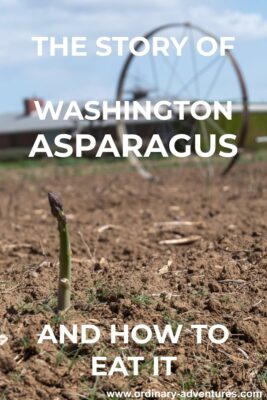The Story of Washington Asparagus
Last Updated on January 11, 2024
Manuel Imperial drives us in his truck along the side of a dusty field. It looks empty, just brown rows as far as I can see. He stops the truck. There are two people barely visible under coats, hats and scarves against the sun, dust and cold wind, containers for harvest mounted to their belts. There must be something growing here. I can’t see it.
Getting out of the truck, walking up to the closest brown row, I see it. A purple and green stalk struggling against the heavy wind to reach for the sun. Now that I’m getting my asparagus eyes on, it is everywhere. Reaching for the sun, poking tentatively through the dirt, only visible from the side, but ready for harvest tomorrow. Growing 6 inches a day, this row will look different in 5 hours from how it looks now. Each individual stalk pushes up alone, though it’s connected to many other stocks below the ground. Asparagus harvesting is an intensely manual process. Each stalk is individually cut and must be harvested daily to maximize the crop.
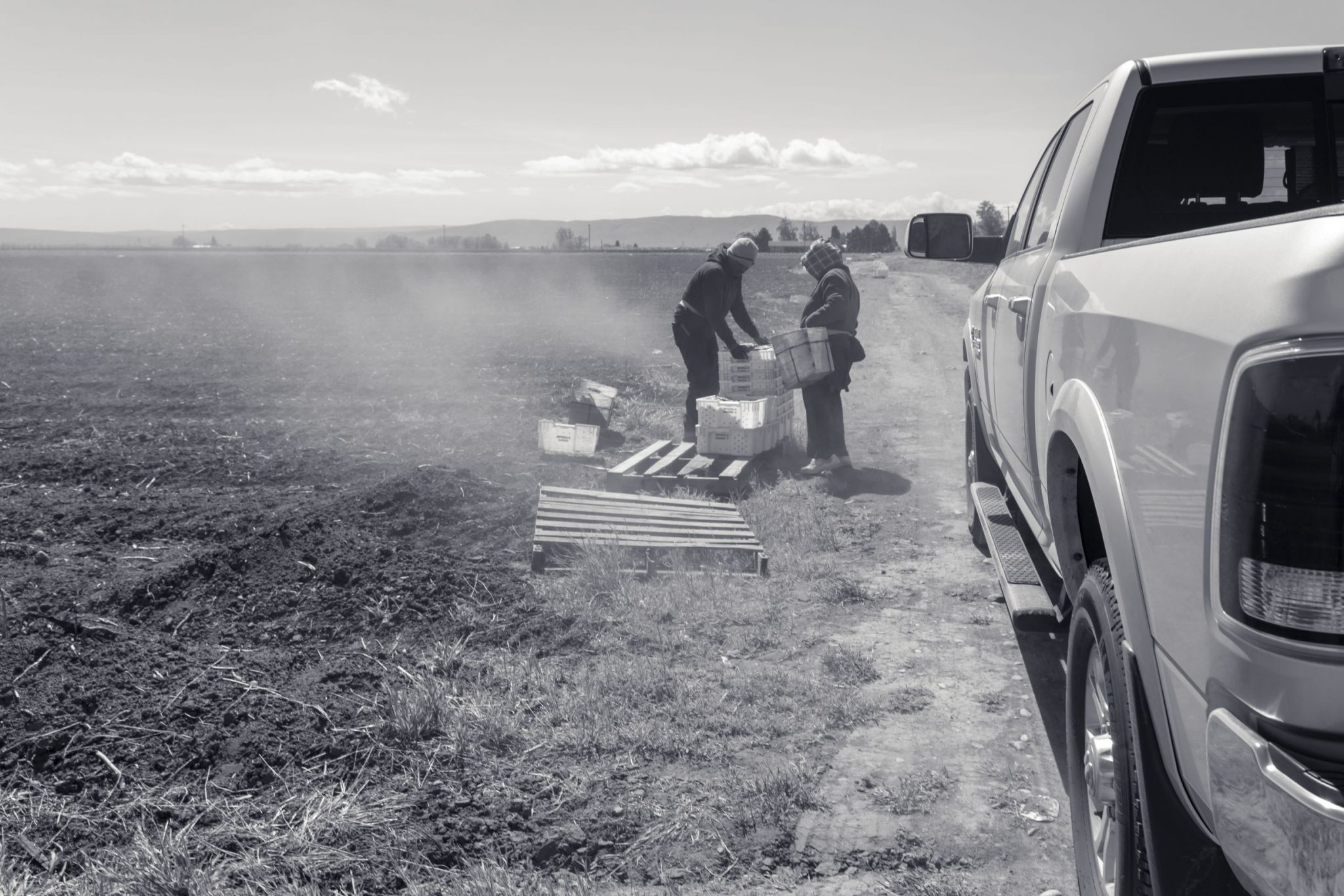
(Photo credit: Jay Flaming)
The married couple who harvest this particular field are up at 5 am and will spend 12 hours harvesting today’s spears, and will do this daily for the two month season. Manuel, an immigrant from the Philippines who came to Washington State as a teenager with his parents and siblings, owns and manages Imperial’s Garden along with his siblings, growing many crops including asparagus. His office is filled with family photos and his desk is covered with complicated metrics for each crop, including asparagus. The amount of data, research and long days needed to manage and compete on a family farm against big agribusiness and imported produce from Mexico is staggering. Despite these challenges, Manuel is generous with his time and his story, even allowing me to take part in the processing where asparagus is washed, trimmed and bundled for travel around the country. He even gave us a huge box of asparagus to enjoy and share with friends and family.
This is asparagus farming in the Yakima Valley.
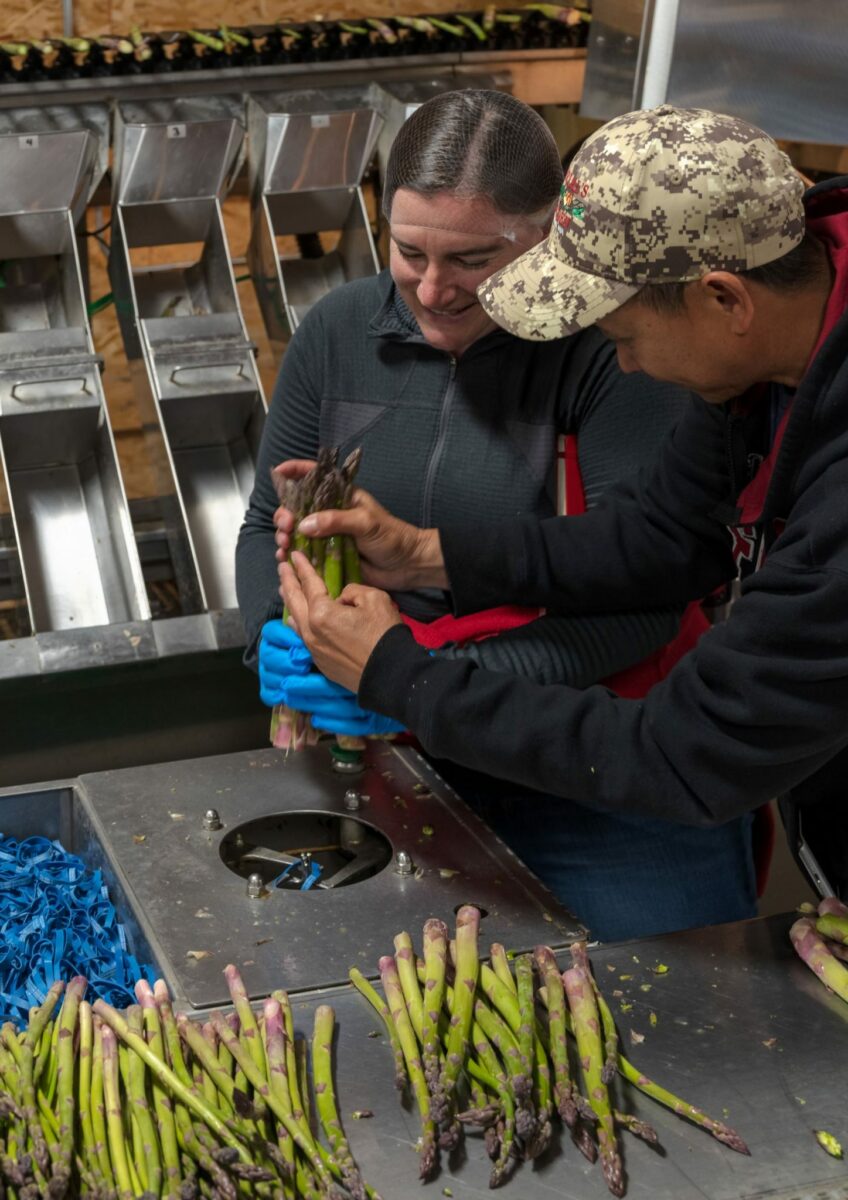
(Photo credit: Jay Flaming)
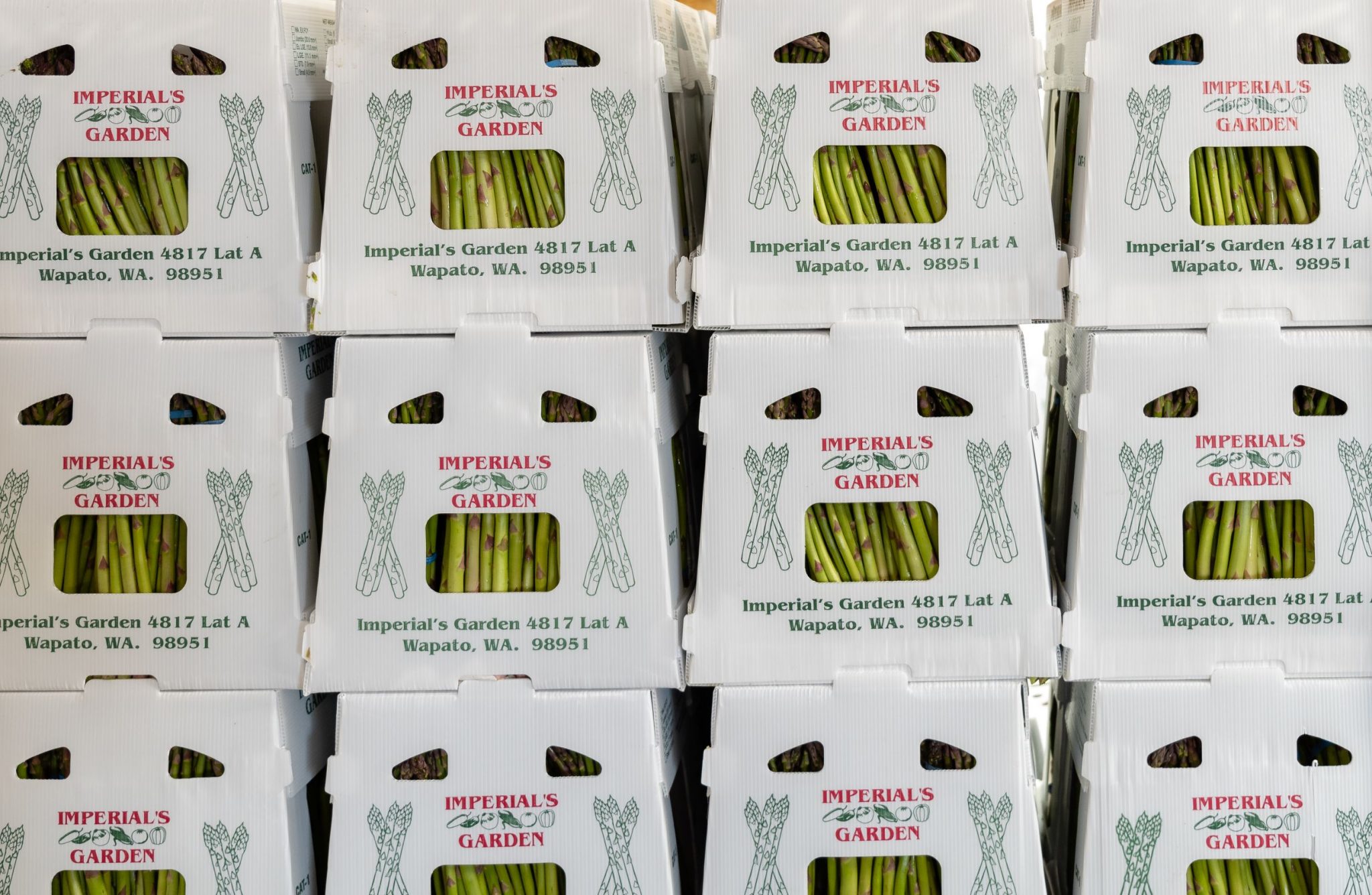
(Photo credit: Jay Flaming)
What’s so great about Asparagus?
The ancient Chinese, Egyptians and Babylonians prized asparagus, which is thought to have originated in the middle east. It spread across the world and is grown in home gardens in a variety of climates. Here in Washington, it thrives in the Yakima Valley and Tri-Cities area, where it is commercially grown and sold all over the country.
In addition to being a delicious, highly seasonal delicacy, asparagus packs a ton of nutrition into a tiny package, it’s loaded with folic acid, Vitamin C, beta-carotene, Vitamin B6, Potassium, Fiber, Vitamin K and Thiamin. These essential nutrients boost your immune system, brain and bone health, protect against cancer and pretty much do good things in your body!

Why does it matter where our food comes from?
Food is food, right? Our bodies need nutrition, food gives it to us, right? In the past, I used to believe this. I was fortunate to grow up in Washington state, with its great climate diversity and lots of local food. Both my grandparents had big gardens that we ate from routinely. It wasn’t until I lived in Alaska that I really learned to appreciate local food. Alaska is incredible for the freshest most delicious fish and wild game that you can imagine, but in the vegetable department local options are very limited and particularly in the small community I lived in in Southeast Alaska, everything was “barge ripened”, expensive and disappointing! I really dove in to the local bounty that was available and vowed I would never take delicious local produce for granted again if I ever moved back home. But why does it matter?
- Connection to other people and the land: Knowing who grows and harvests our food as well as the land it grows on brings a greater deeper connection to community and understanding of the complex current and historical web of climate, environment and culture.
- Fresher: When it comes to freshness, especially crispness and flavor (not to mention keeping a few extra days), the more local the better!
- Adventure: Local, seasonal food is FUN. Sure, it means that you might miss out on a sad, flavorless, stringy imported asparagus spear, but then you can really enjoy all things asparagus when it’s delicious and then move on to experimenting with the next local delicacy (spoiler alert: STRAWBERRIES!).
- Carbon footprint: eating food that’s grown close to home means thousands of miles less driving/railroading/flying for the food you eat which is better for the environment
- Local economy: Eating local supports Washington’s economy and the farmers, field workers and production workers who earn their living growing our food. 90% of Washington’s asparagus crop is sold on the fresh market (as opposed to frozen or canned) and asparagus contributes $50 million to Washington’s economy.
Where can you buy local asparagus?
It is 100% worth it to take a road trip over to the Yakima Valley, where you can buy fresh local asparagus all over the place (Imperial’s Garden is located at 4817 Lateral A Road, Wapato, WA). Less than three hours from Seattle, it’s especially lovely this time of year, when it tends to be warmer and sunnier while we continue our seemingly endless cloudy spring weather in Western Washington. While you’re there, you can take in some wine tasting and some beautiful canyon hikes and even a canyon hike to a winery! Asparagus season lines up nicely with wildflower season in Central Washington…LUCKY YOU. You can also grab lunch or dinner at Los Hernandez where you can sample the change-your-life asparagus and pepper jack tamales (only available during asparagus season, but you can buy frozen ones to take home!).
If you don’t want to take the road trip (you DO want to) or if you already ate your way through the box you acquired on it (anyone else? Just me?) then you can also buy it many places in Seattle. You can buy it at farmers markets as well as Fred Meyer, QFC and PCC. Watch out and make sure it’s local asparagus! It’s tempting to get the less expensive imported asparagus but it is so worth it to get the tender, local asparagus (see all the reasons above why it’s worth it).
If you’re storing it, put it in a vase or jar with water like you would with fresh cut flowers. This will keep it fresh longer, making sure it doesn’t dry out. Put the vase or jar in the refrigerator.
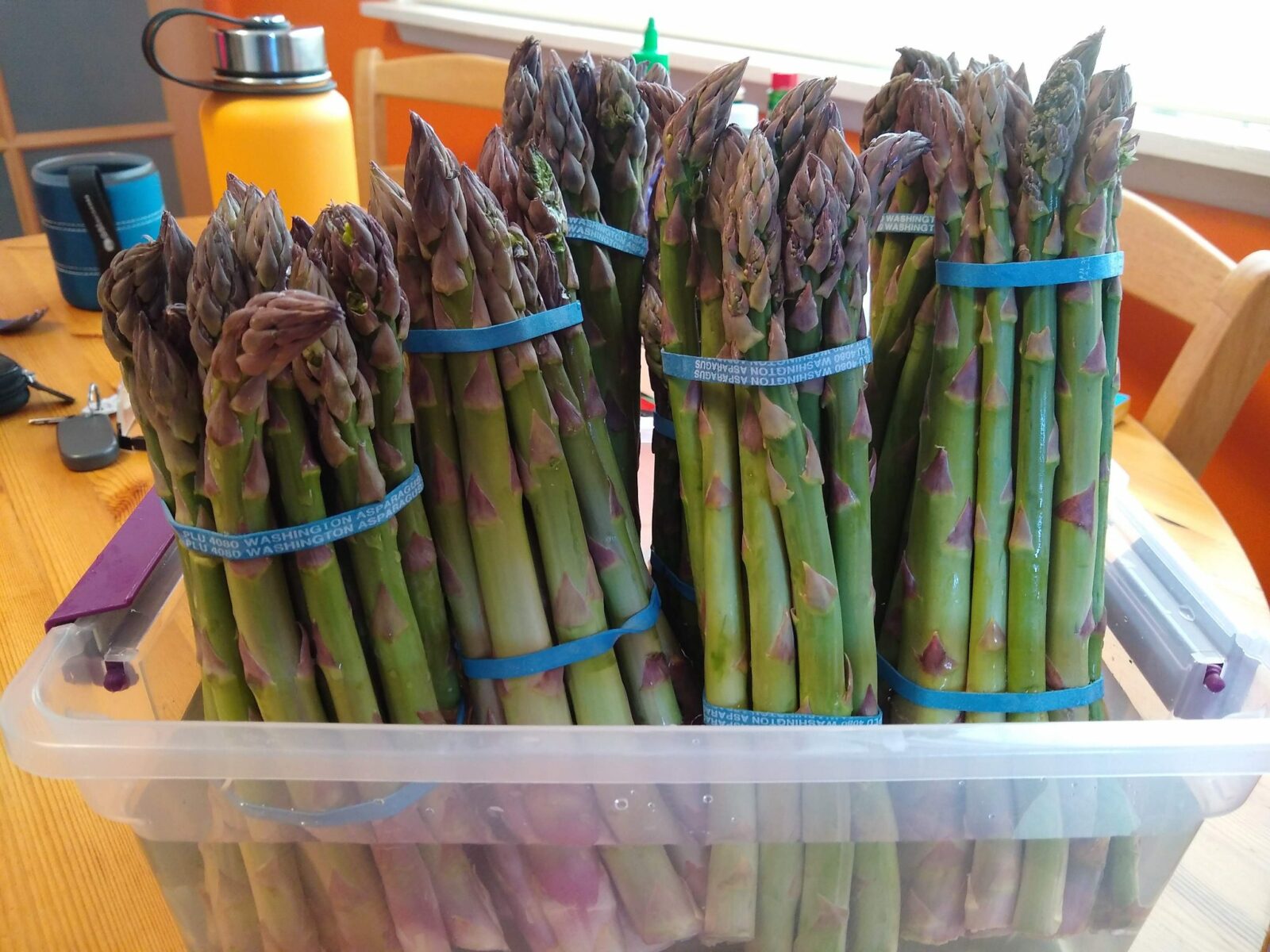
What’s the best way to eat local asparagus?
I believe in cooking it just ever so slightly so it’s still crunchy, either on the grill or stir fried, with a bit of olive oil, salt and pepper (lemon pepper or lemon salt is another fabulous addition). When I say slightly, I mean like less than 5 minutes.
The Washington asparagus commission has lots of recipes for asparagus if you want to get more fancy or creative with it, and if you’re looking to preserve this bounty for other times of the year, you can freeze it, pickle it or dehydrate it (I’ve been adding dehydrated asparagus to my backpacking meals and it’s delicious. Watch out for the dehydrating time, asparagus has a lot of water so I’ve found it takes about 24 hours in the dehydrator).
I asked Manuel what’s his favorite way to eat asparagus. Right away he said “steamed!” and then after a brief pause, he said “actually I really like to just snap off a spear from the garden and eat it. I do this each night when I get home”. I never imagined eating raw asparagus before, wouldn’t it be too stringy?? Leaving the farm, with 15 pounds of asparagus in my lap (the rest of the car being full of Stuart the puppy and his luggage as well as our camping gear), I decided to give it a try. I removed one stalk and bit off the end. Crunchy, tasty, it even tasted green. In that one bite, my relationship with asparagus transformed from admiration and appreciation to magic.
